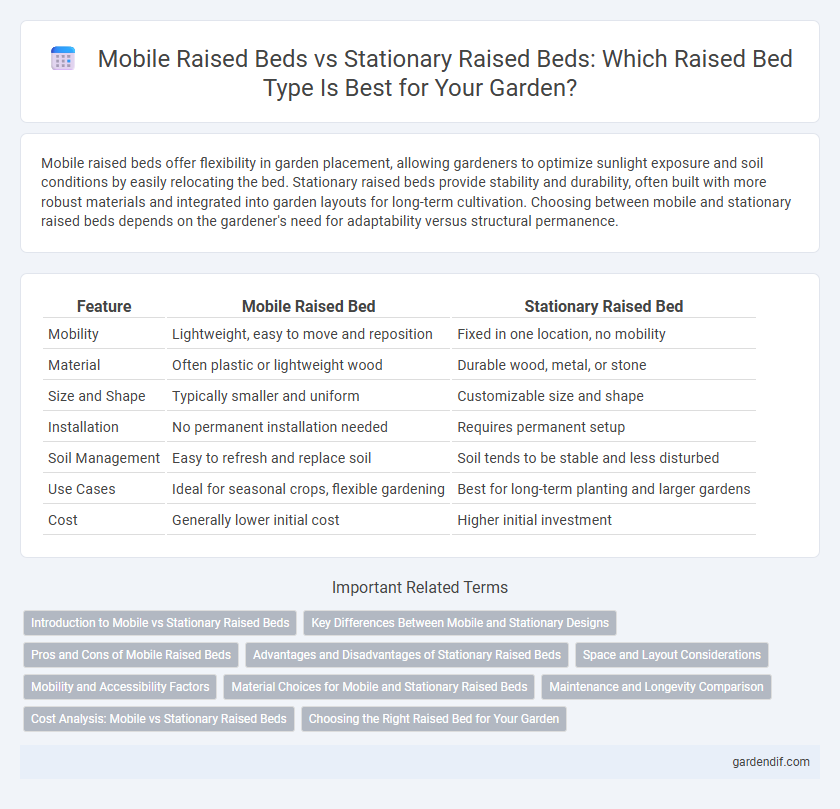
Mobile raised bed vs Stationary raised bed Illustration
Mobile raised beds offer flexibility in garden placement, allowing gardeners to optimize sunlight exposure and soil conditions by easily relocating the bed. Stationary raised beds provide stability and durability, often built with more robust materials and integrated into garden layouts for long-term cultivation. Choosing between mobile and stationary raised beds depends on the gardener's need for adaptability versus structural permanence.
Table of Comparison
| Feature | Mobile Raised Bed | Stationary Raised Bed |
|---|---|---|
| Mobility | Lightweight, easy to move and reposition | Fixed in one location, no mobility |
| Material | Often plastic or lightweight wood | Durable wood, metal, or stone |
| Size and Shape | Typically smaller and uniform | Customizable size and shape |
| Installation | No permanent installation needed | Requires permanent setup |
| Soil Management | Easy to refresh and replace soil | Soil tends to be stable and less disturbed |
| Use Cases | Ideal for seasonal crops, flexible gardening | Best for long-term planting and larger gardens |
| Cost | Generally lower initial cost | Higher initial investment |
Introduction to Mobile vs Stationary Raised Beds
Mobile raised beds offer flexibility by allowing gardeners to relocate them easily for optimal sunlight and soil conditions, making them ideal for small spaces and urban environments. Stationary raised beds provide a permanent gardening solution with enhanced soil structure and stability, supporting long-term plant health and robust root systems. Choosing between mobile and stationary raised beds depends on factors such as garden size, plant type, and the gardener's need for mobility versus permanence.
Key Differences Between Mobile and Stationary Designs
Mobile raised beds offer flexibility and ease of relocation, allowing gardeners to optimize sunlight exposure and soil conditions by moving the bed as needed. Stationary raised beds provide stability and often accommodate deeper root systems, making them ideal for long-term planting in a fixed location. Key differences include portability, soil depth capacity, and suitability for different gardening spaces or crop types.
Pros and Cons of Mobile Raised Beds
Mobile raised beds offer flexible gardening solutions, allowing easy relocation for optimal sunlight exposure and crop rotation, which reduces soil depletion and pest buildup. Their portability can be limited by size and weight, making large mobile beds cumbersome to move, and they may require sturdier construction to withstand frequent handling. While mobile raised beds improve accessibility and adaptability, they often come with higher costs and potential stability issues compared to stationary options.
Advantages and Disadvantages of Stationary Raised Beds
Stationary raised beds offer increased durability and stability, making them ideal for long-term gardening projects and heavy soil use. Their fixed location supports deep root systems and reduces soil disturbance, which enhances plant health and yield. However, they lack mobility, limiting flexibility for crop rotation or seasonal garden redesign, and may require more initial setup time and space.
Space and Layout Considerations
Mobile raised beds offer flexible space utilization by allowing gardeners to move the bed to optimize sunlight exposure and airflow, making them ideal for small or irregular spaces. Stationary raised beds require careful initial placement to maximize garden layout efficiency, often benefiting from permanent integration with pathways and irrigation systems. Choosing between mobile and stationary beds depends on the available space, desired garden layout, and the need for adaptability in plant arrangement.
Mobility and Accessibility Factors
Mobile raised beds offer enhanced mobility, allowing gardeners to relocate plants according to sunlight and weather conditions, improving accessibility for maintenance and harvesting. Stationary raised beds provide a stable and permanent growing area with easier integration into garden layouts but lack the flexibility to adapt to changing environmental factors. Considering mobility and accessibility, mobile raised beds cater to dynamic gardening needs, while stationary beds suit long-term, fixed cultivation plans.
Material Choices for Mobile and Stationary Raised Beds
Mobile raised beds often utilize lightweight materials such as treated wood, composite panels, or aluminum frames to ensure easy mobility while maintaining durability against weather exposure. Stationary raised beds commonly incorporate heavier, more permanent materials like stone, brick, concrete blocks, or untreated hardwood, which provide structural stability and long-lasting endurance in garden settings. Choosing the right material depends on balancing factors like mobility needs, resistance to moisture, and aesthetic preferences to optimize the raised bed's functionality and lifespan.
Maintenance and Longevity Comparison
Mobile raised beds require more frequent adjustments and inspections to ensure wheels and frames remain in good condition, with potential wear from movement affecting longevity. Stationary raised beds typically offer greater durability due to their fixed placement, reducing mechanical stress and simplifying maintenance tasks like cleaning and structural repairs. Choosing between the two depends on balancing ease of relocation with long-term stability and minimal upkeep requirements.
Cost Analysis: Mobile vs Stationary Raised Beds
Mobile raised beds typically involve higher initial costs due to materials like wheels, durable frames, and mobility mechanisms, but they offer flexibility by allowing repositioning for sunlight optimization and space utilization. Stationary raised beds generally have lower upfront expenses, constructed from basic wood or composite materials, but may incur additional long-term costs related to soil amendments and site preparation. Cost analysis must factor in maintenance, lifespan, and potential yield benefits, with mobile beds often justifying higher investment through improved growing conditions and adaptability.
Choosing the Right Raised Bed for Your Garden
Mobile raised beds offer flexibility by allowing gardeners to move plants according to seasonal sunlight and space requirements, enhancing growth conditions. Stationary raised beds provide stability and durability, ideal for permanent garden layouts with established irrigation and soil management systems. Selecting the right raised bed depends on garden size, mobility needs, and long-term cultivation goals to maximize productivity and convenience.
Mobile raised bed vs Stationary raised bed Infographic

 gardendif.com
gardendif.com